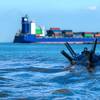In the late spring of 1942, a Japanese carrier strike force launched more than 100 planes from the northwest to conduct an air attack on the U.S. military at Midway Atoll in the middle of the Pacific Ocean.
By 5:30 a.m. that day the United States located and identified the incoming Japanese threat. In an hour�s time, America and Japan engaged in what would later be looked back upon as the most pivotal naval engagement of World War II.
June 4-6 marks the 65th anniversary and remembrance of the confrontation, which genuinely demonstrated the importance of the Navy�s aircraft carriers, after the U.S. fleet sank all four Japanese carriers involved, and consequently neutralized the Pacific front.
Starting with the commissioning of the USS Langley (CV-1) in the early 1920s, the aircraft carrier evolved from a supporting element to the traditional "battleline" of battleships prior to World War II, to the primary capital warship of that war and continuing on until today.
World War II naval leaders quickly saw that the 200- to 300-mile reach of the carrier air group over sea or land was far more flexible and effective than the battleships gunfire range of 10-15 miles.
In the Pacific, from late 1943 the fast carrier forces struck all over the vast Japanese empire destroying their airpower and coastal shipping wherever they could find it. During the hard fought island invasions of 1944-1945 they provided the critical air cover, anti-submarine warfare, and air-ground support needed by the vast armadas of vulnerable amphibious forces.
In the Atlantic, small aircraft carriers built on merchant ship hulls and called "jeep carriers" provided critical defensive anti-submarine escort to the convoys bringing vital supplies to the U.S. and allied forces in Europe. Eventually, some of these small carriers were formed into hunter-killer groups to offensively seek out and destroy the German U-boats before they could threaten and choke off the Allies vital worldwide sea lanes.
Because of this spectacular wartime success, the postwar Navy saw the adoption of even bigger carrier aircraft and bigger carriers. The longer range and weapons carrying ability of these further solidified the carriers� central place in the Navy that remains to this day.
The production and usage of carriers not only prevented the expansion of the Japanese empire, but also simultaneously helped battle German forces in the Atlantic, with only a single American carrier lost to Germany during the war.
Support for aircraft carriers was also brought on in response to the wars in Korea and Vietnam, offering sea-based aircraft for attack missions and air support.
A carrier presence in the Persian Gulf has contributed to maintaining stability throughout the 1990s and, more recently, a capable strike force following the terrorist attacks on the World Trade Center and Pentagon in 2001.
Navy carriers currently are helping to deter terrorist attacks by maintaining a constant presence in the Persian Gulf while administering air strikes in support of land-based troops in Iraq and Afghanistan.
As Carl Vinson continues its Refueling Complex Overhaul (RCOH), the mission of the operational aircraft carriers continues every day in places like the Persian Gulf and oceans throughout the world.
The significance of bringing the aircraft carrier Carl Vinson back for 25 more years of service allows the United States to continue to leverage one of its great national assets: an aircraft carrier at sea.
While Carl Vinson continues to build a new era, one must not forget the legacy, importance, and historical significance the Battle of Midway had on modern aircraft carriers and the Sailors who bring life to these warships.
Carl Vinson is currently undergoing its scheduled RCOH at Northrop Grumman Newport News shipyard. The RCOH is an extensive yard period that all Nimitz-class aircraft carriers go through near the midpoint of their 50-year life cycle.
During RCOH, Carl Vinson�s nuclear fuel will be replenished and the ship�s services and infrastructure will be upgraded to make her the most state-of-the-art aircraft carrier in the fleet and prepare for another 25 years or more of service.
By Mass Communication Specialist Seaman Joel Carlson, USS Carl Vinson Public Affairs
Sponsored Content
Chris-Marine’s solutions help to prolong engine lifetime

Subscribe for
Maritime Reporter E-News
Maritime Reporter E-News is the maritime industry's largest circulation and most authoritative ENews Service, delivered to your Email five times per week












